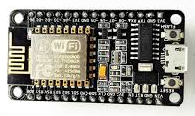 As of a couple of years ago the big thing in microcontrollers was the Arduino. The Arduino was (and still is) a delightful board for hobby projects. But now there’s a new microcontroller board for hobby projects, namely the fetchingly named ESP8266 ESP-12E NodeMCU board, pictured at right. There are many nice things about this board. The main nice things about the ESP8266 (just as with the Arduino) are:
As of a couple of years ago the big thing in microcontrollers was the Arduino. The Arduino was (and still is) a delightful board for hobby projects. But now there’s a new microcontroller board for hobby projects, namely the fetchingly named ESP8266 ESP-12E NodeMCU board, pictured at right. There are many nice things about this board. The main nice things about the ESP8266 (just as with the Arduino) are:
- programmable via a simple USB cable from your notebook computer
- general-purpose I/O pins that are easy to connect to
- analog-to-digital converter (ADC) input
- powerful programming language that is an extension of c++
- PWM (pulse width modulated) outputs
- reasonably priced
The ESP8266 is the next big thing in microcontrollers for several reasons:
- built-in wifi (2.4 GHz 802.11 b/g/n)
- built-in TCP/IP stack
- built-in WPA/WPA2 wifi encryption
- 32-bit RISC CPU running at 80 MHz
- typical 4 megabytes of flash memory
- native ultra-low-power “sleep” mode
- easy to program using the familiar Arduino IDE (integrated development environment)
- physically smaller than the Arduino board
You can see the wifi antenna on the left side of the photograph. You can buy two of these boards for $16. The SOC (system on a chip) is made by Shanghia-based Expressif.
My first project, which I will detail in a future blog post, is an internet-of-things application. The project monitors the sump pump in my house. Each time the sump pump runs, the ESP8266 powers up, connects to the wifi in my house, gets an IP address, and establishes an SSL encrypted link to IFTTT (if this then that). IFTTT then logs the event to a spreadsheet in my Google docs, and sends me an email message.
My second project, which I will detail in another future blog post, is another internet-of-things application. The project monitors a sensing loop buried in the driveway to my house. Each time a vehicle passes over the sensing loop, the ESP8266 fires off an encrypted message to IFTTT. IFTTT then logs the event to a spreadsheet in my Google docs, and sends me an email message.
Oh, yes, IFTTT. If you have not already done so, you will want to explore IFTTT. It is another next big thing.
